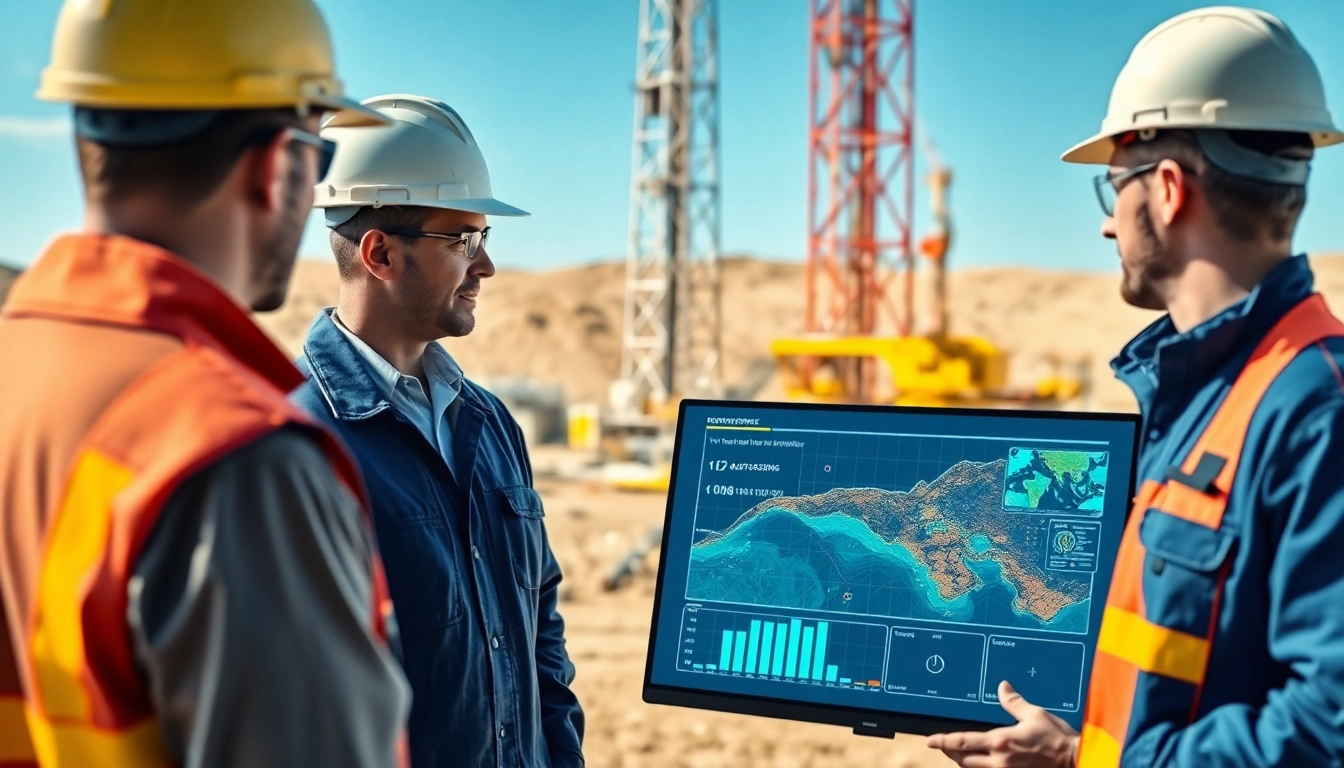Understanding Geosteering Techniques with www.geosteeringvision.com
Geosteering, a critical process in modern drilling operations within the oil and gas industry, transforms traditional drilling methods into more adaptive and efficient practices. By utilizing real-time data to navigate the geological complexities of subsurface formations, geosteering allows drilling teams to optimize well placements, ensuring maximum extraction and minimizing operational costs. This article explores the intricacies of geosteering techniques, particularly through the lens of www.geosteeringvision.com, highlighting essential components, best practices, common challenges, and future trends in the field.
What is Geosteering?
Geosteering refers to the practice of adjusting the drill bit’s trajectory based on real-time geological data. Traditionally, drilling has relied heavily on pre-drilled geological surveys and maps; however, these methods are often limited in their adaptability to the unpredictable nature of subsurface formations. In essence, geosteering integrates real-time data from various sources, such as mud logging, geological mapping, and geophysical surveys, to provide drilling crews with a dynamic view of the subsurface environment. This enables highly precise drilling, ensuring that the wellbore remains in targeted zones rich in hydrocarbons.
The Importance of Real-Time Data
Real-time data is the cornerstone of effective geosteering. Utilizing advanced technologies such as downhole sensors, telemetry systems, and data acquisition software, geosteering teams can access instantaneous feedback regarding subsurface conditions. This information is vital for making informed decisions during drilling. For example, if a drill encounters unexpected rock types, the team can quickly adjust the drilling parameters—such as angle, rate of penetration, and bit size—to accommodate these changes and maintain the well within the desired reservoir.
Geosteering in Fluctuating Geologies
The subterranean landscape is inherently variable, filled with zones of differing geology. These fluctuations can be due to several factors, including soil composition, structural formations, and geographical changes. Geosteering excels in such environments by offering the ability to adapt drilling paths based on real-time geological insights. By successfully navigating through these varying formations, geosteering reduces the risk of drilling into unproductive zones and maximizes the yield from productive reservoirs. It also minimizes the risk of drilling hazards such as lost circulation or wellbore instability.
Key Components of Successful Geosteering
Data Acquisition and Analysis
Data acquisition forms the backbone of geosteering, requiring an array of tools and techniques to gather and interpret geological data accurately. Advanced sensors provide continuous monitoring of various parameters, including lithology, porosity, and fluid properties. Analyzing this data involves utilizing sophisticated software systems that can integrate and interpret complex datasets to provide actionable insights. Moreover, the analysis should be conducted collaboratively among geologists, engineers, and drilling personnel, ensuring that everyone is aligned with the real-time data and the drilling trajectory adjustments.
Technology Utilization in Drilling
The advancement of technology has significantly impacted the efficacy of geosteering. Modern drill rigs are equipped with top-notch drilling automation technologies, including rotary steerable systems, while customizable software allows for enhanced data visualization. These technologies not only streamline the process of collecting and interpreting data but also drastically improve communication among team members. The effective utilization of technology allows for precise directional drilling, enhanced well placement accuracy, and ultimately, a reduction in drilling costs.
Project Management Considerations
Effective geosteering is not solely based on technical capabilities but requires efficient project management strategies. This encompasses clear communication, thorough planning, and team coordination. Project managers must integrate geosteering goals into the broader drilling strategy, ensuring that all members are informed about the objectives and the tools available to achieve these goals. Additionally, risk management frameworks should be established to prepare for potential challenges, evaluating both geological uncertainties and technical limitations of the equipment being utilized.
Best Practices for Effective Geosteering
Implementing a Geosteering Plan
The formulation of a comprehensive geosteering plan is essential for successful operations. This plan should outline the geological objectives, data acquisition strategies, and response protocols to unforeseen events. Factors such as subsurface complexity, environmental considerations, and historical performance of similar wells should inform the geosteering plan. A well-defined strategy enables teams to avoid common pitfalls and remain focused on achieving optimal drilling results.
Monitoring and Adjusting Techniques
Continuous monitoring of drilling performance alongside real-time geological data is paramount for proactive decision-making. Establishing key performance indicators (KPIs) allows teams to track metrics such as drilling rate, bit wear, and geological indicators systematically. Teams should also implement a feedback mechanism that facilitates prompt adjustments based on performance analytics, enhancing operational agility. When unexpected geological conditions arise, having predefined adjustment protocols can significantly mitigate risks and help maintain drilling efficiency.
Training Geosteerers and Technicians
Education and training remain vital components of a successful geosteering operation. Ensuring that geosteerers and drilling technicians possess a solid understanding of geological principles and operational protocols enhances adaptability to real-time challenges. Continuous training programs should be established to keep personnel updated on technological advancements and evolving best practices. Additionally, encouraging a culture of collaboration and knowledge sharing within the team fosters a cohesive work environment, essential for effective problem-solving and communication.
Common Challenges in Geosteering
Dealing with Geological Uncertainty
Geological uncertainty is one of the most significant challenges faced in geosteering. Subsurface formations are rarely uniform, and unexpected changes in lithology can dramatically impact drilling performance. Employing statistical models and simulation tools to predict potential geological scenarios helps teams prepare for uncertainty. Moreover, drilling teams should maintain flexibility in their operational strategies, allowing for quick adaptations to unforeseen conditions without significant delays or cost overruns.
Overcoming Data Integration Issues
Integrating data from various sources remains a challenge in the geosteering process. Discrepancies between datasets can lead to misinterpretation and less effective drilling strategies. To overcome this, establishing standardized data formats and utilizing robust software capable of processing disparate data types is crucial. Empowering teams to work collaboratively on data analysis fosters a holistic understanding of the subsurface environment and enhances decision-making precision.
Addressing Team Communication Gaps
Effective communication among team members is vital to the success of geosteering. Misunderstandings or lack of information can lead to poor decisions and disastrous outcomes during the drilling process. Emphasizing the importance of open communication channels, regular briefings, and comprehensive reporting structures can mitigate these gaps. Implementing collaborative tools and technologies also enhances visibility across the team, ensuring that all members have access to up-to-date information necessary for cohesive operation.
Future Trends in Geosteering with www.geosteeringvision.com
Emerging Technologies and Innovations
The evolution of geosteering is closely linked to advancements in technology. Emerging tools, such as drones for aerial mapping, enhanced downhole sensors, and advanced data visualization software, are pushing the frontiers of geosteering practice. Innovations in 3D modeling and simulation techniques allow for more accurate predictions of subsurface conditions, facilitating better decision-making in real-time. The integration of these technologies into routine operations will likely shape the future of geosteering, enhancing efficiency and productivity.
Increased Automation in Drilling Processes
Automation is on the rise in the oil and gas sector, significantly impacting drilling practices. Automated systems reduce the need for constant human intervention, minimizing the likelihood of errors and optimizing performance. These systems can automatically adjust drilling parameters based on real-time data, allowing for faster responses to changing conditions. As automation technologies continue to develop, they will play a pivotal role in revolutionizing geosteering methodologies, resulting in safer and more efficient operations.
The Role of Artificial Intelligence and Machine Learning
Artificial Intelligence (AI) and Machine Learning (ML) are becoming integral to geosteering practices. AI algorithms can analyze vast amounts of geological data and recognize patterns that humans might overlook. Implementing ML systems can aid teams in predicting geological behavior based on historical drilling data, enhancing decision-making capabilities. As the technology matures, integrating AI and ML into the geosteering workflow promises to refine accuracy and efficiency while reducing risks associated with conventional drilling practices.


